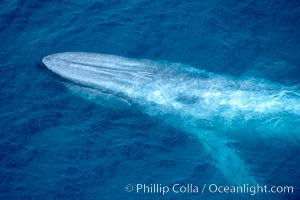
Blue whale. The sleek hydrodynamic shape of the enormous blue whale allows it to swim swiftly through the ocean, at times over one hundred miles in a single day.
Species: Blue whale, Balaenoptera musculus
Location: La Jolla, California
Image ID: 21250
Species: Blue whale, Balaenoptera musculus
Location: La Jolla, California
Image ID: 21250

Fin whale underwater. The fin whale is the second longest and sixth most massive animal ever, reaching lengths of 88 feet.
Species: Fin whale, Balaenoptera physalus
Location: La Jolla, California
Image ID: 27116
Species: Fin whale, Balaenoptera physalus
Location: La Jolla, California
Image ID: 27116

Aerial photo of blue whale near San Diego. This enormous blue whale glides at the surface of the ocean, resting and breathing before it dives to feed on subsurface krill.
Species: Blue whale, Balaenoptera musculus
Location: San Diego, California
Image ID: 39422
Species: Blue whale, Balaenoptera musculus
Location: San Diego, California
Image ID: 39422
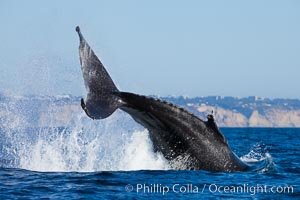
A humpback whale performs a peduncle throw in which it uses its long pectoral fins as levers to swing its fluke and caudal stem out of the water, flinging water everywhere., the coast of Del Mar and La Jolla is visible in the distance.
Species: Humpback whale, Megaptera novaeangliae
Location: Del Mar, California
Image ID: 27142
Species: Humpback whale, Megaptera novaeangliae
Location: Del Mar, California
Image ID: 27142
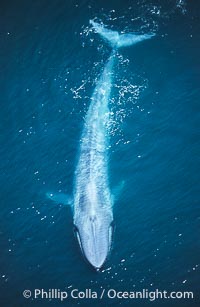
A huge blue whale swims through the open ocean in this aerial photograph. The blue whale is the largest animal ever to live on Earth.
Species: Blue whale, Balaenoptera musculus
Image ID: 02169
Species: Blue whale, Balaenoptera musculus
Image ID: 02169
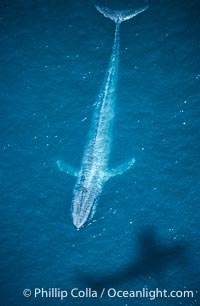
Blue whale aerial photo, with the shadow of the survey plane providing scale as to how huge the whale really is.
Species: Blue whale, Balaenoptera musculus
Image ID: 02168
Species: Blue whale, Balaenoptera musculus
Image ID: 02168
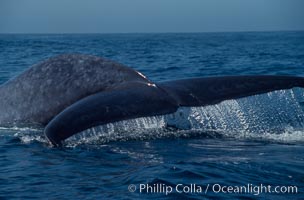
Blue whale fluking up (raising its tail) before a dive to forage for krill, Baja California (Mexico).
Species: Blue whale, Balaenoptera musculus
Image ID: 03332
Species: Blue whale, Balaenoptera musculus
Image ID: 03332

Red gorgonian and California golden gorgonian on underwater rocky reef, San Clemente Island. The golden gorgonian is a filter-feeding temperate colonial species that lives on the rocky bottom at depths between 50 to 200 feet deep. Each individual polyp is a distinct animal, together they secrete calcium that forms the structure of the colony. Gorgonians are oriented at right angles to prevailing water currents to capture plankton drifting by.
Species: Red gorgonian, California golden gorgonian, Leptogorgia chilensis, Lophogorgia chilensis, Muricea californica
Location: San Clemente Island, California
Image ID: 38499
Species: Red gorgonian, California golden gorgonian, Leptogorgia chilensis, Lophogorgia chilensis, Muricea californica
Location: San Clemente Island, California
Image ID: 38499
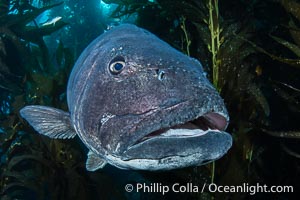
Closeup Portrait of the Face of a Giant Black Sea Bass, showing parasitic sea lice. The sea lice are parasites that find their nutrition from the skin and blood of the host giant sea bass. Smaller fishes such as senoritas and wrasses will commonly clean the sea lice off the giant sea bass.
Species: Giant black sea bass, Stereolepis gigas
Location: Catalina Island, California
Image ID: 39436
Species: Giant black sea bass, Stereolepis gigas
Location: Catalina Island, California
Image ID: 39436
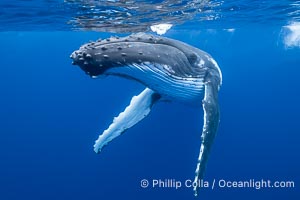
South Pacific Humpback Whale Underwater, Moorea, French Polynesia.
Species: Humpback whale, Megaptera novaeangliae
Location: Moorea, French Polynesia, France
Image ID: 40662
Species: Humpback whale, Megaptera novaeangliae
Location: Moorea, French Polynesia, France
Image ID: 40662

Solitary inquisitive humpback whale underwater near the island of Moorea, French Polynesia.
Species: Humpback whale, Megaptera novaeangliae
Location: Moorea, French Polynesia, France
Image ID: 41333
Species: Humpback whale, Megaptera novaeangliae
Location: Moorea, French Polynesia, France
Image ID: 41333

Solitary inquisitive humpback whale underwater near the island of Moorea, French Polynesia.
Species: Humpback whale, Megaptera novaeangliae
Location: Tahiti, French Polynesia, France
Image ID: 41334
Species: Humpback whale, Megaptera novaeangliae
Location: Tahiti, French Polynesia, France
Image ID: 41334

Solitary inquisitive humpback whale underwater near the island of Moorea, French Polynesia.
Species: Humpback whale, Megaptera novaeangliae
Location: Tahiti, French Polynesia, France
Image ID: 41336
Species: Humpback whale, Megaptera novaeangliae
Location: Tahiti, French Polynesia, France
Image ID: 41336

Solitary inquisitive humpback whale underwater near the island of Moorea, French Polynesia.
Species: Humpback whale, Megaptera novaeangliae
Location: Tahiti, French Polynesia, France
Image ID: 41337
Species: Humpback whale, Megaptera novaeangliae
Location: Tahiti, French Polynesia, France
Image ID: 41337

Young humpback whale underwater near Tahiti.
Species: Humpback whale, Megaptera novaeangliae
Location: Moorea, French Polynesia, France
Image ID: 41340
Species: Humpback whale, Megaptera novaeangliae
Location: Moorea, French Polynesia, France
Image ID: 41340
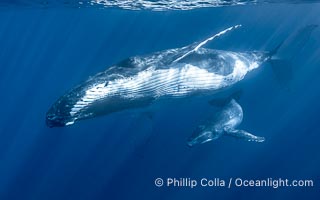
Humpback mother and calf swimming together underwater, Moorea Island, French Polynesia.
Species: Humpback whale, Megaptera novaeangliae
Location: Moorea, French Polynesia, France
Image ID: 41341
Species: Humpback whale, Megaptera novaeangliae
Location: Moorea, French Polynesia, France
Image ID: 41341

Solitary inquisitive humpback whale underwater near the island of Moorea, French Polynesia.
Species: Humpback whale, Megaptera novaeangliae
Location: Moorea, French Polynesia, France
Image ID: 41368
Species: Humpback whale, Megaptera novaeangliae
Location: Moorea, French Polynesia, France
Image ID: 41368

Young sea lion hides in an underwater crevice.
Species: California sea lion, Zalophus californianus
Location: Sea of Cortez, Baja California, Mexico
Image ID: 31226
Species: California sea lion, Zalophus californianus
Location: Sea of Cortez, Baja California, Mexico
Image ID: 31226
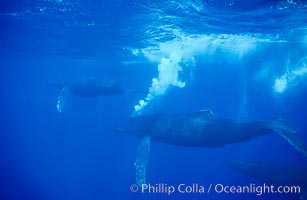
Adult male humpback whale bubble streaming underwater. The male escort humpback whale seen here is emitting a curtain of bubbles as it swims behind a female (left) during a competitive group. The bubble curtain may be meant as warning or visual obstruction to other male whales interested in the mother.
Species: Humpback whale, Megaptera novaeangliae
Location: Maui, Hawaii
Image ID: 02828
Species: Humpback whale, Megaptera novaeangliae
Location: Maui, Hawaii
Image ID: 02828
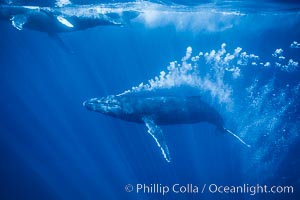
Adult male humpback whale bubble streaming underwater. The male escort humpback whale seen here is emitting a curtain of bubbles as it swims behind a mother and calf. The bubble curtain may be meant as warning or visual obstruction to other nearby male whales interested in the mother.
Species: Humpback whale, Megaptera novaeangliae
Location: Maui, Hawaii
Image ID: 05925
Species: Humpback whale, Megaptera novaeangliae
Location: Maui, Hawaii
Image ID: 05925
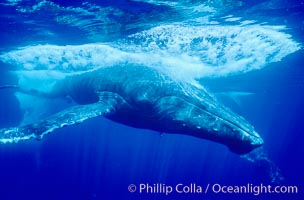
North Pacific humpback whale, escort in competitive group makes fast close pass.
Species: Humpback whale, Megaptera novaeangliae
Location: Maui, Hawaii
Image ID: 06057
Species: Humpback whale, Megaptera novaeangliae
Location: Maui, Hawaii
Image ID: 06057

Blue whale, raising fluke prior to diving for food, fluking up, lifting tail as it swims in the open ocean foraging for food.
Species: Blue whale, Balaenoptera musculus
Location: San Diego, California
Image ID: 40608
Species: Blue whale, Balaenoptera musculus
Location: San Diego, California
Image ID: 40608
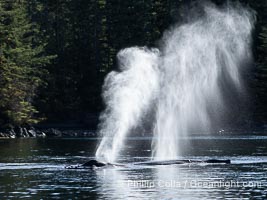
Humpback whale breath hanging in cold still air, Southeast Alaska.
Species: Humpback whale, Megaptera novaeangliae
Location: Sitka Sound, Alaska
Image ID: 40964
Species: Humpback whale, Megaptera novaeangliae
Location: Sitka Sound, Alaska
Image ID: 40964

Humpback Whale Breaching near Tahiti and Moorea, French Polynesia.
Species: Humpback whale, Megaptera novaeangliae
Location: Moorea, French Polynesia, France
Image ID: 41338
Species: Humpback whale, Megaptera novaeangliae
Location: Moorea, French Polynesia, France
Image ID: 41338

Scripps Pier solstice, surfer's view from among the waves, sunset aligned perfectly with the pier. Research pier at Scripps Institution of Oceanography SIO, sunset.
Location: Scripps Institution of Oceanography, La Jolla, California
Image ID: 30150
Location: Scripps Institution of Oceanography, La Jolla, California
Image ID: 30150

Bald eagle in flight, snow covered beach and Kachemak Bay in background.
Species: Bald eagle, Haliaeetus leucocephalus, Haliaeetus leucocephalus washingtoniensis
Location: Kachemak Bay, Homer, Alaska
Image ID: 22592
Species: Bald eagle, Haliaeetus leucocephalus, Haliaeetus leucocephalus washingtoniensis
Location: Kachemak Bay, Homer, Alaska
Image ID: 22592
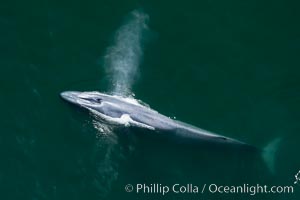
Blue whale, exhaling as it surfaces from a dive, aerial photo. The blue whale is the largest animal ever to have lived on Earth, exceeding 100' in length and 200 tons in weight.
Species: Blue whale, Balaenoptera musculus
Location: Redondo Beach, California
Image ID: 25951
Species: Blue whale, Balaenoptera musculus
Location: Redondo Beach, California
Image ID: 25951
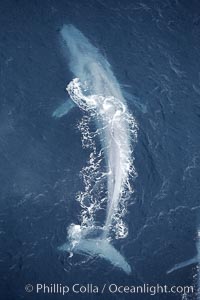
Blue whale. The entire body of a huge blue whale is seen in this image, illustrating its hydronamic and efficient shape.
Species: Blue whale, Balaenoptera musculus
Location: La Jolla, California
Image ID: 21251
Species: Blue whale, Balaenoptera musculus
Location: La Jolla, California
Image ID: 21251

Blue whale. The entire body of a huge blue whale is seen in this image, illustrating its hydronamic and efficient shape.
Species: Blue whale, Balaenoptera musculus
Location: La Jolla, California
Image ID: 21252
Species: Blue whale, Balaenoptera musculus
Location: La Jolla, California
Image ID: 21252

Blue whale and San Onofre Nuclear Power generating station, raising fluke prior to diving for food, fluking up, lifting its tail as it swims in the open ocean foraging for food.
Species: Blue whale, Balaenoptera musculus
Location: Dana Point, California
Image ID: 27337
Species: Blue whale, Balaenoptera musculus
Location: Dana Point, California
Image ID: 27337